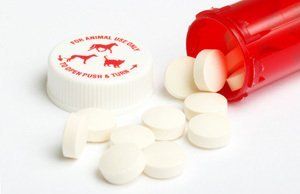Acute Hemorrhagic Diarrhea Syndrome in Dogs (Hemorrhagic Gastroenteritis)
websitebuilder • May 27, 2019

What is acute hemorrhagic diarrhea syndrome?
Acute hemorrhagic diarrhea syndrome (AHDS) (also known as hemorrhagic gastroenteritis [HGE]) is an acute (sudden) disorder of dogs characterized by vomiting and bloody diarrhea. Most cases occur without warning in otherwise healthy dogs. The main and most disturbing clinical sign is large amounts of bloody diarrhea, very often bright red. Some dogs may have a painful abdomen, decreased appetite, lethargy (fatigue), or fever.
Diarrhea — Yorkshire Terrier Lying On Bed in Clarksville, IN
AHDS can affect any breed, age, size, or gender of dog, but it is most common in small- and toy-breed dogs. Young Miniature Poodles, Miniature Schnauzers, and Yorkshire Terriers seem to be more commonly affected. Other breeds commonly affected include the Pekingese, Dachshund, Maltese, Cavalier King Charles Spaniel, Shetland Sheepdog, and Poodle.
What causes AHDS?
The exact cause of AHDS remains unknown (idiopathic). It may be related to dietary indiscretion (ingesting non-food items or different foods), immune-mediated disease, toxins, or pancreatitis. Stress, anxiety, and hyperactivity are thought to be possible contributing factors in many cases. Other possible causes of AHDS include:
- stomach or intestinal ulcers
- trauma
- gastrointestinal tumors or obstruction
- foreign bodies
- infectious diseases such as canine parvovirus infection
- coagulation disorders
- intestinal parasites
- intestinal bacteria
Recent research indicates that AHDS may be an allergic reaction (food or inhaled). Dogs who experience AHDS may be more prone to developing AHDS in the future.
How is AHDS diagnosed?
The diagnosis of AHDS may be challenging and may ultimately require intestinal biopsies in persistent cases. Because there are so many possible causes of AHDS, evaluation usually requires a complete blood count (CBC), biochemical analysis of the blood, urinalysis, radiographs (X-rays), coagulation or clotting tests, fecal evaluation, and ultrasound or endoscopic examination of the gastrointestinal tract.
The packed cell volume (PCV) or hematocrit (HCT)—a measurement of the proportion of red blood cells in the blood—is often greater than 60% in dogs with AHDS. Most dogs have a normal HCT of 37% to 55%. An elevated HCT in combination with a low or normal total protein is an important clue that a dog may have AHDS. Blood bicarbonate levels, blood pH levels, and serum chemistries also give indicators that AHDS may be present. Diagnosis is often a process of eliminating other causes of bloody stools and gastrointestinal distress.

How is AHDS treated?
Dogs with AHDS will appear severely ill and, if left untreated, may die. In most cases, the disorder appears to run its course in a few days if the dog is given appropriate supportive care. Intravenous fluid therapy with potassium and electrolyte supplementation provides the foundation of AHDS therapy. Subcutaneous fluids (fluids given under the skin) are not usually considered adequate to meet the significant fluid requirements of most dogs with AHDS. Most dogs are not fed during the first 24 hours of treatment and are often given antibiotics for example ampicillin, enrofloxacin, or metronidazole (brand name Flagyl®) to combat potential secondary intestinal infection.
Trauma — Puppy with IV Fluids in Clarksville, IN
"Dogs with AHDS will appear severely ill and, if left untreated, may die."
Additional therapy for AHDS may include gastrointestinal protectants (e.g., sucralfate, brand names Carafate® and Sulcrate®) and anti-vomiting medications (e.g., maropitant, brand name Cerenia®). In severe cases, plasma or colloids may be needed to correct severely low blood protein levels.
If intravenous fluid therapy is not given, the dog’s red blood cell count will continue to elevate because of dehydration. In this situation, the dog is at risk for a potentially fatal clotting disorder called disseminated intravascular coagulation (DIC). Once DIC has begun, it is often irreversible and may result in death.
Can AHDS be prevented?
Since the cause is unknown, it is difficult to give advice on prevention. However, reasonable suggestions are to feed a high quality commercial diet, refrain from giving your dog extra foods or treats your dog is not accustomed to, use parasite preventive medications as directed by your veterinarian, and generally provide a low stress environment.
This client information sheet is based on material written by: Tammy Hunter, DVM; Ernest Ward, DVM
© Copyright 2018 LifeLearn Inc. Used and/or modified with permission under license.

Acetazolamide (brand names: Diamox®) is a diuretic and antiglaucoma agent, used primarily to treat glaucoma (increased eye pressure), syringomyelia (cyst that affects nervous system), and metabolic alkalosis. Its use in cats and dogs to treat glaucoma, syringomyelia, or metabolic alkalosis is ' off label ' or ' extra label '. Many drugs are commonly prescribed for off label use in veterinary medicine. In these instances, follow your veterinarian’s directions and cautions very carefully as their directions may be significantly different from those on the label.



